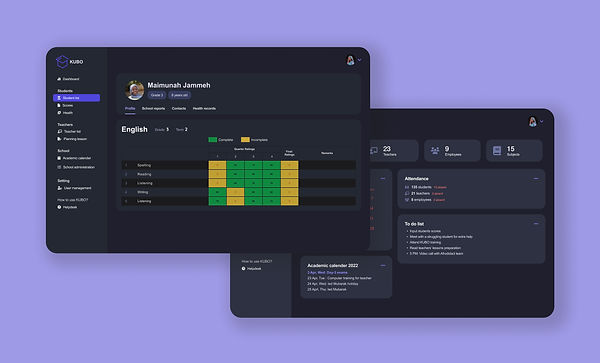Optimized KUBO software to help teachers in isolated Gambia schools, to work more efficiently
.jpg)

My volunteering time for KUBO wasn’t just about design project. It was an adventure I’ll never forget. I got a fun opportunity to improve KUBO, a school management software that works without internet connection. This powerful tool helps teachers and school staff in isolated areas to manage their students' scores and data in a simple and efficient way. Seeing KUBO make a real impact on their day-to-day challenges was incredibly fulfilling.
Curious to see our work?
Overview
My roles
-
UX/UI Designer
-
UX Researcher
Team
-
1 Project Manager
-
1 UX/UI Designer
-
4 Developpers
-
3 Marketers
Tools
-
Figma
-
Miro
Others
-
When: May 2022 - December 2022
-
Scope: I redesigned some parts of the software.
-
Constraint: software on desktop
-
It's a volunteer project.
Goals
To make the software more intuitive for users (teachers and school staff).
Outcomes
✔ 3 new features:
-
feature to filter students based on certain categories
-
dashboard to see overview of school administration
-
freature to track student progress fast
✔ More intuitive experience
✔ Design documentation
Teachers in The Gambia spend more time on paperwork than teaching
With expensive and weak internet, teachers in The Gambia have no choice, but to rely on paper for everything. Manually record students' scores and data, track students' progress, to manage school administration. But this manual method is slow and tiring. Consequently, they hardly focus on the main task, which is teaching. Worst of all, when floods occur. Their written records can be damaged and some are gone, adding their frustration.


Learning activities at Albreda school. Lack of electricity and internet.


.jpeg)
Some students' scores and school administrations are written manually on paper.
Therefore KUBO is created, as the solution for schools in isolated areas. Throughout KUBO platform, school staff can manage school administration digitally and efficiently.
Currently, KUBO platform is running in The Swallow school in The Gambia. Soon, we will be working in another isolated area in Africa, thanks to our donors on Afrodidact. (Finger crossed).


Ahmed, a happy local who can use a computer for the first time in his life.
Computer class in The Swallow school.

Even while KUBO operates, teachers & school staff still do some tasks manually
To identify users' challenges within KUBO software, I created an offline survey, face-to-face interview, and usability test with questions to discover what frustrated them when using KUBO. This research has been done with the help of The Swallow school headmaster. I discovered:
Users still create student lists based on certain categories manually, either on paper or using offline computers, which is time-consuming and inefficient.
Track students' progress manually
Tracking student progress is still done manually, making the process slow and time-consuming.
To track school activities and administration, users still do it manually through papers-based book and external app.
Solutions
Based on the user pain points, usability test and what users need, KUBO can provide:
Dashboard overview
Users can overview effortlessly the school's administration and activities.
Student analytic
Students' analytics to track students' progress fast and to identify which subjects that students need extra help.
Easy to input data
Simple way to input students' scores, grades, data.
Filter students based on certain categories.
To help new users learn how to use this platform since some of them are new computer users.
The original design
 |  |
|---|---|
 |  |
User Research
As a users' advocate, I wanted to understand the teachers and school staffs better: their problems, behavior, and needs. So I used 2 methods:

To understand the real challenges of teachers and school staff while using KUBO, I conducted user interviews and usability tests in 2 schools in The Gambia. Those were The Swallow school and Albreda school. I interviewed teachers, headmaster, and school staffs.
What categories should be on students' filter feature? what other tasks that users still do it manually?
I got a report from the headmaster of The Swallow school that the teachers still find it difficult to filter students based on specific needs for events, lessons, and administration. The process is mostly done manually, costing them time and energy.
To truly understand their challenges, we are conducting interviews and usability tests to explore:
-
How confident teachers are with computers. Are they beginners or experienced users?
-
How they currently filter students and what categories they use.
-
What other manual processes that slow them down.
By gathering this insights, we can improve KUBO based on what KUBO's users need.
What features and elements to help KUBO's users?
I did competitive research from similar products to get insights about the trend and how these softwares handle the 3 frustrations of users: to filter students, to track progress, and to track school administration in fast way. This insight I can use to design KUBO software, based on KUBO users' needs.

Overcome the cultural barriers to get honest feedback
Getting honest feedback from Gambian participants took more time. I compared it to what I experienced with Europeans in my past projects. I noticed Gambian participants tend to be very polite and might avoid critical feedback, as they see it as possibly disrespectful.
When I tested KUBO with Gambian teachers and a headmaster, they initially said everything was good, but they struggled to accomplish tasks. I realized I needed to build more trust and create more safe space for open communication. I assured them that honest feedback, even if it was negative, was crucial for improving the platform and making it helpful for their work. Bit by bit, their feedback became more open and honest.

User personas
Based on the user research and user group, I created 3 user personas to represent KUBO's users with different backgrounds and needs.

Isatou
42 years old
headmaster and teacher
lives in Serrekunda
Pains:
To overview administration of schools, she needs to open it in several platforms.
Goals:
-
To know and analyse fast the school administration and actvities
-
Able to know all features in Kubo platform

Ida
35 years old
teacher
lives in Serrekunda
Pains:
-
To track her students' progress, she needs to open each student's profile and analyze it manually
-
Still learning using computer (lack of digital skill)
Goals:
-
Quickly evaluate her students progress and then adapt her teaching methods effectively.
Ahmed
50 years old
English teacher
lives in Serrekunda
Pains:
-
Still learn how to operate computer, newbie in digital
-
Struggle to create manually a list of students who speak Wollof and have bad scores in English lessons
Goals:
-
Spend more time preparing and delivering extra English lessons.
-
Use KUBO independently without relying on others.



Isatou
Headmaster

Ahmed
Teacher
Users stories
Ida
Teacher
"I want to check the administration of my school, academic performance, schedule, or any issue in a fast way, so that I can work efficiently"
"I want to track students' progress easily, so that I can adjust my teaching methods"
"I want to be able use KUBO platform in easy way to find fast all students who speak Wollof and have bad scores in English, so that I can spend my time more on preparing the extra English lesson and giving lessons"
Value Proposition Design

Wireframes


I redesigned KUBO platform with dark mode. A change that saves power, which is important in places with limited electricity like the schools in The Gambia.
By using less bright light on the screen, dark mode helps KUBO run longer without draining the battery. And as a bonus, it’s easier on the eyes for users during those long-hardworking hours.
Next improvement
We take more time to design a feature for teachers' need that help them finding or filtering students based on scores. In order to take immediate action such as providing students additional support to improve.
Developing
Now, I'm teaming up with the developers to bring this design to life. Stay tuned ✨
Breadcrumb navigation
This handy feature acts like a guide, helping users know exactly where they are and track their steps. No more confusion or second-guessing. Just a seamless journey through the software.
FAQ feature
From my research with KUBO users, I discovered some teachers and staff are new to using computers and KUBO software, so they often ask their colleagues for assistance. By providing a simple Frequently Asked Question, users could be more independent and not always relying on others to help them.





What I learned
3
It took more time to get honest feedback
Because of cultural differences, it took longer to get honest feedback from Gambian participants compared to Europeans in a previous projects. I found Gambian participants are polite and avoid giving critical feedback, as they may see it as disrespectful. When I tested the platform with Gambian teachers and a headmaster, they initially said they were satisfied, but struggled with using it. So, I worked to build trust and encouraged them to share their feedback, even if it was negative feedback, because it would help improve the platform.
2
We only have four developers as volunteers, the limited electricity with solar panels, and the unstable internet connection in The Gambia. It takes more time to get information from the school staffs and to develop new features. So, patience is key.
1
Before going to The Gambia, I often compared my life in Indonesia, a third-world country, to Europe. Indonesia always seemed left behind in education, science, and technology. But when I visited The Gambia, I realized how lucky I was to have had access to technology and a good education from a young age. Even though it may not have been the best, I still had more access than many.
In The Gambia, I met people raround 5 to 50 years old who were incredibly happy because we set up computer classes in their villages. It was their first time ever using a computer!
Interested to join us or donate?
Please visit https://www.afrodidact.org/














.jpg)




